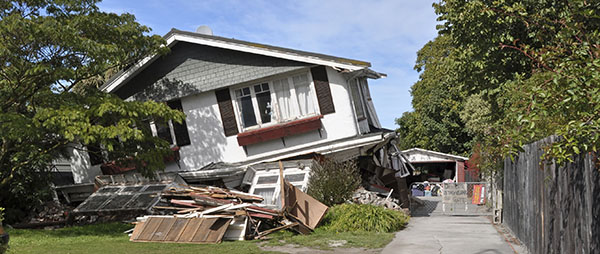Inevitable Nature
Earthquakes are an inevitable phenomena of nature that can cause devastating damage and loss in just a few seconds. If your home is not built or designed to withstand the massive earth movements, there will likely be damages to the infrastructure, personal unattached property in or around the home, and even broken gas/water pipes that can cause further damage afterwards.
Though California is known to be the U.S. state with the most earthquakes, this is actually false. Alaska has had the most earthquakes, though most major shakes happen in remote locations. Up until 2014, California came in second as the most active with 200. Surprisingly, Oklahoma became the second most active in 2014 with 585 earthquakes. However, it is noted that California does have the most damaging earthquakes because of a greater population and more infrastructure.
What Does Earthquake Insurance Cover?
Because of these unpreventable natural occurrences, what we can do is prepare for the safest way to get through the event. Besides preparing safety kits and preparing escape plans for your family, Earthquake Insurance will help you get back on your feet in the aftermath of a damaging earthquake. A quick 10 second earthquake can cause a total of more than $5 billion in damage. How much are you going to lose if the worse happens? Are you going to be able to rebuild and repair with funds out of your own bank account?
Unfortunately, Earthquake Insurance isn’t a standard coverage on your Homeowners or Renters Insurance policy. Earthquake Insurance gives you assurance that you have financial assistance if an earthquake were to happen in your area. Here are just a few things that Earthquake Insurance will give you coverage for:
- Dwelling – replacement or repair of property damage caused by the earthquake
- Extensions to Dwelling – Equipment and utility services that are damaged and affect the living conditions of the dwelling are covered. This includes: electric, telephone, gas, heating, oil, water, septic, and sanitary sewage systems.
- Personal Property – personal property damaged in the earthquake and found in the residence, such as camera equipment for computers are covered under this coverage.
- Loss of Use – If the part of the home that you occupy has become unlivable, you can get covered for the additional increase in income necessary to maintain your current standard of living. Expenses will be paid for the shortest amount of time that is reasonably needed to repair or replace the dwelling.
Learn more about Earthquake Insurance Coverage here
Fact or Fiction
Below are a few facts and myths about earthquakes that are good to keep in mind. If you still aren’t sure about the potential of earthquakes, knowing these facts can help you understand the possibilities of this natural event.
Earthquake Facts
- Most Californians live within 30 miles of an active fault
- San Francisco earthquake of 1989, only 15 seconds long caused over $5 billion in damages
- The biggest U.S. earthquake was recorded to be at Prince William Sound, Alaska at 9.2-magnitude, taking the lives of 131 people on march 28, 1964
- An Aftershock can be greater than the initial shock. In this case, the first shock becomes the foreshock and the second becomes the mainshock
- Tsunamis are caused by movements that happen suddenly in the ocean as a result of earthquakes, landslides on the sea floor, volcanic activity, meteorite impact or land slumping into the ocean
- It is estimated that over 500,000 earthquakes happen worldwide every year. Though only about 100,000 of those can be felt and approximately 100 will cause damage
Earthquake Myths
- California will fall into the ocean
- The earth can open during earthquakes
- An earthquake on the San Andreas Fault can cause a tsunami
- A large earthquake can be prevented by a lot of little ones relieving the pressure
- The weather has been hot and rainy, it must be earthquake weather
- The doorway is the safest spot for protection during an earthquake (It might have been once upon a time, but in modern houses the doorway is no stronger than other parts of the house)
 Preparing for Earthquakes
Preparing for Earthquakes
It’s not just large earthquakes that cause devastation. Earthquakes cause buildings and their contents to shake, so if your home was not designed to withstand such movement you may find yourself having to rebuild your home. There have been cases of large earthquakes that didn’t cause building damages or injury because they were designed to bear the shaking; other cases of smaller earthquakes have causes a lot of damage because an infrastructure wasn’t updated to survive the movement.
A few things to keep in mind when preparing for an earth quake, are:
- Create an earthquake preparedness plan, including: a meeting place to reunite, safety spots to “DROP, COVER, AND HOLD ON,†and plans for at work or your child’s school.
- Know where and how to shut off your home’s gas, electricity and water.
- Find your closest fire station and Police Department
- Take and pass a Red Cross First Aid and CPR Training Course.
- Put together disaster kits to put in multiple locations, like your car, at work, in the basement, etc. These should include unperishable food, flashlights and batteries, first-aid kits, work gloves, shoes, matches, prescription medication (unexpired), waterproof containers, water, copies of insurance policies and other items that you will need to survive for 3-days (per person).
- Secure to the wall (with bolts) loose furniture, such as bookcases, shelves, file cabinets and other tall furniture that may fall over.
- Get your house inspected to see if any updates are needed to better withstand a big earthquake. Check your foundation, water, gas and electric. Be sure that these can withstand the shaking as well as not cause any damage afterwards, such as a gas leak causing a fire.
Read more about Earthquake Insurance Coverage
 Do you need Earthquake Insurance?
Do you need Earthquake Insurance?
3 zones of the earth are in the areas of known earthquake belts: circum-Pacific seismic belt, the Alpide, the submerged mid-Atlantic ridge. The circum-Pacific belt is along the rim of the pacific, where the ocean meets the western part of land (i.e. Western United States). The Alpide runs through the Himalayas, the Mediterranean and out into the Atlantic Ocean. The submerged mid-Atlantic ridge contains the third zone of earthquakes; earthquakes are strewn in various areas of the world. In the United States, Missouri and South Carolina on the East felt the shaking.
This is to say that earthquakes are unpredictable and can happen anywhere in the world. Not all faults have been discovered yet, either. It could be a year or a hundred before an undiscovered fault causes a detectable earthquake. It would be a good idea to have coverage should these events occur. You won’t have to take on 100% of the responsibility to pay for repair, restructuring or rebuilding your home after a damaging earthquake. Be prepared with Earthquake Insurance for the next one to come.
Want to learn more about getting Earthquake Insurance Coverage?
The information in this article was obtained from various sources. This content is offered for educational purposes only and does not represent contractual agreements, nor is it intended to replace manuals or instructions provided by the manufacturer or the advice of a qualified professional. The definitions, terms and coverage in a given policy may be different than those suggested here and such policy will be governed by the language contained therein. No warranty or appropriateness for a specific purpose is expressed or implied.


